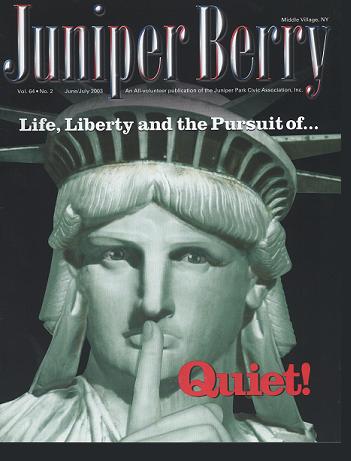There was much celebrating when the area located south of the LIE, North of Eliot Avenue from 74th to 86th Streets, formerly known as (South) Elmhurst, joined Middle Village on January 28, 2003 and adopted its 11379 zip code. While there was joy in Midville, a man on the other side of the LIE, lamenting Elmhurst’s recent downsizing, said to his wife, “honey, they shrunk the neighborhood.”
Dejuvu, perhaps. Elmhurst, once a much larger entity, had its beginning about 350 years ago when the Maspeth colony, devastated by native Americans, moved in 1652 to safer grounds to what is now Broadway and Queens Boulevard. The English colonists, required by the Dutch authorities to take a Dutch name, chose Middleburgh. New Amsterdam fell to the English in 1664 and in 1683 Queens was reorganized on the English model into a county and five towns.
|
Newtown, one of the five towns, (so named because it was a new town then), consisted of all northwest Queens, including the entire JPCA area, the other four towns were Flushing, Jamaica, Hempstead and Oyster Bay, the latter two now Nassau County. Middleburgh became the Village of Newtown. Here were located the Town Hall, jail, tax office and Town Clerk’s office. Farmers came from miles away to vote, to go to the three churches clustered there and to shop.
N ewtown slept through most of the nineteenth century until the coming of the northside railroad in 1854 and the Grand Street horse car line in 1876. Newtown experienced shrinkage when on May 4, 1870, the heavily populated and industrialized area comprising Astoria, Ravenswood, Hunters Point and Dutch Kills, having nothing in common with rural Newtown, seceded from Newtown and formed Long Island City. A major factor in the secession was the physical distance of the town government, (Broadway and Queens Boulevard), from Long Island City. Sound familiar?
Newtown Becomes Elmhurst
In 1896, Cord Meyer bought up some farms and began his high class housing development along Elmhurst and Whitney Avenues. In what goes around comes around, Cord Meyer had the postal authorities change the name of Newtown Village to Elmhurst in 1897 because of the stench in the Newtown Creek caused by industrial pollution.
With consolidation in 1898, Queens became one of New York City’s five boroughs and all the old towns, including Newtown, went out of business on December 31, 1897.
Elmhurst, now just another Queens neighborhood, would grow into a bustling community.
Probably the most important factor in this growth was the opening of the Queensborough Bridge in 1909, which ended Queen’s dependence on ferry service to reach Manhattan. Queens Boulevard, a two-lane country road up until now, suddenly found itself a major traffic artery. Between 1914 and 1915 Queens Boulevard was widened to 200 feet. Between 1912 and 1914 the Manhattan-Queens trolley line was built from Manhattan along the entire length of Queens Boulevard to Jamaica.
The intersection of Broadway and Queens Boulevard (Elmhurst) was now the major crossroads of Queens.
The old face of Elmhurst was altered by the coming of the IND subway in 1936, destroying many of the village landmarks in 1936 but vastly stimulating local growth. A further alteration was the cessation of Manhattan & Queens, (now Green Bus Lines Q60), and Queens Boulevard trolley service in 1937. The last Elmhurst trolley (Flushing-Ridgewood), ended in 1946. The enduring steel thread through time, linking the sleepy Village of Newtown with the Elmhurst of red brick houses and terraced high rises, was gone.
Today, Elmhurst is a busy, up-to-date, heavily populated community, a favorite with recent Asian immigrants. The name Newtown, all but forgotten, is still found in the Grand Avenue IND subway station and the high school which bears its name. A few years ago Elmhurst shrunk vertically when its landmark gas tanks were demolished. May out of their ashes, like a Phoenix, a Newtown arise!


